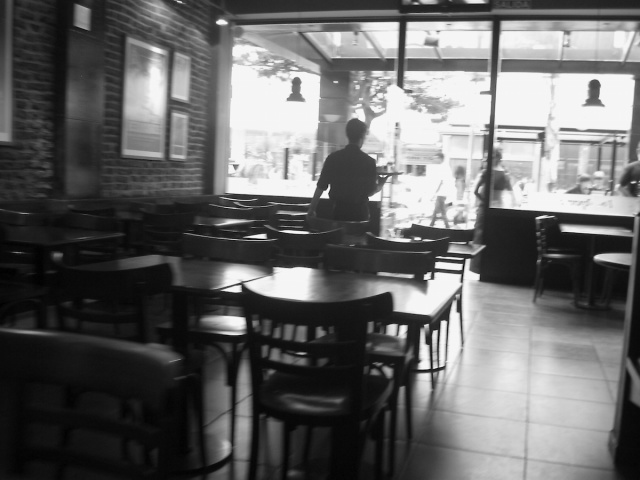[Author’s Note: Writing this story reminded me of my own year tending bar at the defunct Kona Ranch Steak House by the airport. I’d hit the bar myself many nights after a shift. On one night, I sat next to a regular, and, over time, quite naturally consumed a whole bottle of wine. After getting into an argument with the woman, I remember her saying, “You sound just like my ex-husband.” I felt then and now that she was exaggerating for dramatic effect, but I also remember thinking that I was spending a lot of nights drinking, when maybe I should have been thinking about how to find another job, or maybe a place to live that wasn’t my mom’s house …. ]
It’s fun, flexible and easy cash, but ask any server or young professional about their time taking tables in the food service industry, and they’ll describe a world that’s often hard to leave.
A party lifestyle develops
John Selvidge, 40, returned to Oklahoma City from Atlanta after earning an advanced degree in the humanities. He picked up a job at the erstwhile Prohibition Room and since has worked at a variety of more upscale, fine-dining establishments (where he claims a select few waiters can make $70,000 yearly).
Selvidge says that when you’re off at midnight and don’t have to be back at work until 4 p.m. the next day, your definition of fun can change. Selvidge noted that with constant cash coming in, a party lifestyle develops for the waiter, with an emphasis on the here and now. That short-term life is not conducive to investing in health care, for example. The culture and industry itself is built around booze and excess, so it’s something staff must approach with caution.
“I’ve seen it take people over,” he said. “I’ve also known several who have gone to get treatment for heavier substance-abuse issues. Then I know some people who party really hard who seem to do just fine. It’s one of those things where you gotta know what you’re getting into, but also at the same time, all that obviously can be very fun.”
Today, Selvidge will watch the younger servers experience the go-go-go atmosphere and get fired up over the course of a shift about drinking heavily come closing time. Selvidge will still have a couple of beers after work, but now he usually stops at three.
He can attest to the serious energy coursing through one’s body after a shift.
“That’s what those shots are for,” Selvidge said. “To put yourself out of commission.”
‘I was always trying to get out’
Bobbie Gray bounced around different serving jobs in Oklahoma City for seven years during her 20s while also pursuing an associate’s degree in graphic design. She squeezed in classes at UCO and OCCC when she could, or she’d hold two service jobs at once and work 60 to 70 hours a week. Meanwhile, life’s expenses continued to add up.
“Sometimes I knew I was spending money [when] I knew I shouldn’t have,” Gray said. “But really I just didn’t make enough money. It was quick money, easy money. If I was in a bind, I could pick up a shift, so I think that’s the convenience of it.”
Gray said she spent too much energy going out. Often, she and many of her fellow waiters at the vegan establishment Matthew Kenney would spend all their tips on drinks.
“I was a little bit more smart about it,” Gray said “I would take out a budget from my wallet and lock the rest in my glove box.”
Later, Gray worked part-time at Starbucks to get health insurance, filling out up to seven job applications for graphic-design jobs a week. She never got used to waking up at 5 a.m. and started taking naps in her mid-20s. Sometimes she felt like passing out at work.
“There were times the last few years when I was trying to get a design job, and I was getting really depressed,” Gray said. “I started wondering whether I chose the right path. I questioned my skills as a designer. Had I wasted too much time? But I was always trying to get out. It’s hard to get an office job. It’s hard to get a job making more than $12 an hour, even if you have a college degree.”
Lenora LaVictoire’s lipstick field test
Lenora LaVictoire, 20, never considered herself a feminine person. She doesn’t do her hair really. Doesn’t do make-up. But she would test things out while working at two pizza places and a downtown cafe. Lipstick, for example.
“That’s, like, a good test, you know?” she said. “Like you wear lipstick one day, and you haven’t really ever worn it. So you start wearing lipstick just one day. And you notice everyone’s a little bit nicer to you. And you are like, ‘Hmm, maybe I should try this again.’ And so the next day you wear lipstick. You make sure to have it on the whole shift, and you’ll just notice little shit like that will up your (tip) percentage 3 or 4 percent. It’s crazy.”
LaVictoire said she has learned “class consciousness” while waiting tables, something that wasn’t quite as clear before, even though she experienced similar tension attending a high-performance high school and serving 30 hours a week.
“You have daily examples of why you are inferior to these people,” she said. “Why do they treat you [like an] inferior when they don’t know you? So you have to think back, and you have this really good example of society’s crappy backside. You see that every day. It can either wear you down or make you really conscious of it.”
LaVictoire said she has gained a hardcore empathy for any person who does any job.
“It doesn’t matter if you think their job is inferior because you went to six years of college for your job and you make more than them. They are doing this job. Give them the dignity and respect that anyone doing their job should receive.”
Gray has similar sentiments about wealthy customers who treated her badly, but uses the experience more as a consciousness elevator.
“For me, I felt sorry for those people, really. I didn’t’ feel like any less of a person,” Grey said. “I feel like people like that are kind of clueless. They don’t really live in reality. Anyone who treats their server as less than an equal just because they were bringing their food out, that’s not someone who lives in reality. They don’t understand the value of their own dollar.”
‘The enjoyment of the job’
Since Gray finally landed a graphic-design gig at a real estate agency, she hasn’t had to continue service work like some of her co-workers at Starbucks. Many worked there full-time for the health insurance. She feels her lifestyle is healthier. She’s not as stressed about how much money she’s going to have the next week. There’s yoga and more of a social life.
LaVictoire is taking time off from waiting to work on her school paper and study.
Selvidge has been updating his resume, writing and getting excited about future prospects. After his shift to fine dining, most times Selvidge said he can wait on diners enjoyably.
“Even now, I still find it very compelling most nights,” he said. “[It’s] contact with people, at times when they are maybe sort of at their best, just enjoying good food, good drink, a night out in a certain spirit of celebration. And that actually carries over into the enjoyment of the job.”






















